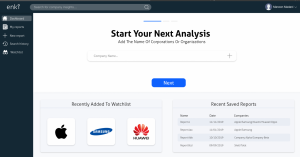In previous articles, we talked about the increase of competitiveness in enterprise sales, the buyer’s advantage, and sales intelligence tools. The next step is to help you to put them into practice. That massive pile of data is great, but it needs to be ready and prepared to retrieve actionable insights. In this modern-day and age, buyers are getting smarter with their decision-making due to a considerable amount of data available. Salespeople need to up their ante as well. After all, you get only one chance to make an excellent first impression. Walk away today, knowing four tactics to use actionable insights smartly.
1. Understand your prospect
First and foremost, nobody ever got far with a pitch that isn’t relevant for their business. We can look at the TV series Shark Tank as an example. Even the most aesthetically pleasing products won’t be convincing enough if the pitch isn’t tailored to the prospect’s company. It’s incredibly essential to understand what your potential client wants and needs before you offer your product.

Thanks to sales intelligence tools, it’s now easier and faster than ever to find information about a company’s essential features, such as company size, location, and industry. Not to mention discovering the more hidden traits, such as the products and technologies they use, their investments, and potential accounts.
Enki’s advanced AI software scrapes the web from your inserted query based on the company, industry, its attributes, and/or job titles of prospects. This data is visualized through area charts, noise indices, word clouds, and article extractions. The AI uses Natural Language Processing (NLP) to populate the correct fields of the query, all collected in one big database. In short, with EnkiAI, you’ll always find the right information about your prospects without spending hours on the web:
2. Identify your accounts
With the rise of competition in B2B sales and marketing comes a required innovative mindset to keep up if not beat competitors. A Forrester report shows us that sales reps spend a lot of time on administrative tasks, meetings, and research. That’s normal as the modern buyer is technical and has a detailed set of expectations. However, these buyers have less time to sell as targets are pushed up either to meet demand or to stay relevant among the intense competition.
It is, therefore, a must that you identify accounts prior to reaching out to prospects. What type of business is it? For example, large, medium, or small enterprise. Who are the key people to talk to in the company, is it very layered? Enki can provide insights on the potential and executive accounts as well as investments, partnerships, and more.

3. Choose the best tool
We all know that manually browsing numerous of websites and news sources for finding information is a tedious task. It would be an understatement to say that finding the all-knowing sales intelligence tool is easy. It takes time, effort, and a great deal of patience. While one executive or manager prefers to research in peace, the other needs a hand. This is why it’s so important to do your homework and have your client profiles mapped out.
To hand you a timesaver, use a smart AI aggregator like Enki that does the work for you. After you run one or several reports to your liking, quickly pick the insights that fit your client’s profile. Is it a major corporation in the oil and gas industry? Take a look at their investments and business initiatives, for example. Or is it a service that targets fast-scaling IoT companies? A glance at their pain points, potential accounts, or market outlook.
4. Take note on insights
It makes perfect sense to write down your findings on a piece of paper. Or in a word document. Make sure you organize it in a way where you don’t get lost. Especially if you have to go through dozens of leads. Start with categories based on target personas, industries, and (executive) level. Assign each lead to the appropriate group and run your query (or queries) with a tool like Enki. It’s easier to read your notes back when you organize them on different levels. A top-down approach goes from market outlook (macro), the business, and its product(s), to the prospect you talk to as an individual (micro). Based on the actionable insights you pick, you can now easily craft a convincing story to pitch your opportunity. With relevance. With meaning.
Conclusion
In short, gain a full understanding of your potential buyer. Identify your accounts to know who you’re targeting. Then select the best tool that will give you a bunch of data to draw actionable insights from. Executing these steps will give you the competitive edge to outmatch other market players. Followed by categorizing your data and adjusting it to your pitch. Simply put, a good structure in your sales process helps you to reel in those qualified prospects efficiently.
To see what EnkiAI can offer you, read more about us or contact one of our professionals.


Hi Priscilla,
These are very good insights. Could you tell me more about how your tool help me understand my prospects? Do you have any examples?
Best,
John T. Account Manager